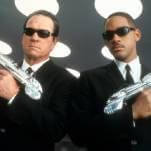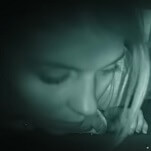In 1931, with a handful of silent shorts and features under his belt, director Jean Renoir made a tentative transition to sound cinema with “On Purge Bébé,” a broad comedy about an upper-class household put on edge by a constipated child. The 45-minute film isn’t that funny; and Renoir himself has said that he only took the job to prove to the bankers that he could deliver a profitable product. But in an interview on Criterion’s new Blu-ray of Renoir’s full-length 1931 film La Chienne (which also contains “On Purge Bébé” as a bonus feature), scholar Christopher Faulkner says the French master quickly realized the possibilities of sound, even while cranking out a thudding farce. Later in the decade, Renoir would establish his place in the pantheon with Boudu Saved From Drowning, Grand Illusion, The Rules Of The Game, and “A Day In The Country,” all of which are renowned for a level of realistic dialogue and naturalistic performance that would’ve been difficult to achieve in the silent era. But as Faulkner notes, even beyond the conversations, the director figured out how to use sound the same way he used images: to compress the storytelling, and to generate atmosphere.
In La Chienne, sometimes that’s as simple as letting the traffic from the street and an incessant out-of-tune piano establish the noisy, distracting neighborhoods where the characters dwell. Based on a Georges De La Fouchardière novel (adapted by Renoir himself), the film stars Michel Simon as Maurice, a middle-class sad-sack store-clerk with a shrewish wife and pie-in-the-sky aspirations to become a painter. One night, as Maurice is stumbling home from an office party, he comes across a pimp, Dédé (Georges Flament) smacking around one of his prostitutes, Lulu (Janie Marèse). After Maurice intervenes, Dédé pulls Lulu aside and orders her to cozy up to this well-dressed dope, to see what she can squeeze out of him. Soon, the clerk is visiting the prostitute regularly and showering her with gifts—including his artwork, which Dédé then sells for exorbitant prices at a local gallery, under Lulu’s name.
That plot may sound familiar to film noir devotees, since it was later remade by director Fritz Lang—almost beat-for-beat—as his 1945 classic Scarlet Street. But story aside, the two movies couldn’t be much more different. Lang’s take is pitched between morality tale and nightmare, tracking a nebbish who turns down the wrong corner at the wrong time and ends up ruining his already pathetic life. Renoir, though, claims no message for La Chienne. In an opening puppet show (!) that introduces the characters, a little doll insists that this movie is neither a comedy (though it is at times comic) or a tragedy (though it involves crime and punishment). Instead it’s just a reflection of reality: a little taste of Paris between the wars, with some sex and violence for seasoning.
That puppet show isn’t the only stylistic flourish that Renoir brings to La Chienne. Unlike in the static, stage-bound “On Purge Bébé,” Renoir has his cinematographer Theodor Sparkuhl move the camera frequently, roaming down rain-slicked cobblestone streets at night and spinning around the dance floors at private clubs. Some filmmakers worried that the introduction of heavy sound equipment to motion pictures would eliminate expressive mise-en-scène, but Renoir found a way to keep tracking and dollying all over the place, while recording sound directly instead of relying on dubbing.
In Ginette Vincendeau’s liner notes for the Criterion edition, the King’s College professor points out that one of the most pointed ways that Renoir uses sound in La Chienne is something non-French-speakers might miss. Besides the clamor from the street—which sometimes includes music, deployed diegetically—the distance between social classes in this film is indicated by the accents. Still, even those who can’t tell from the dialects alone who’s educated and who’s not should be able to pick up on Maurice’s meek stammer. And thanks to the pitch of the voices and the directness of the words, it’s easy to sense the skewed dynamic when Lulu girlishly begs Dédé for more of the money she’s making for him and he shrugs her off, saying, “A smart dame always finds a way.”
La Chienne doesn’t have the thematic depth or resonance of the multiple masterpieces that Renoir was about to make. And to some extent, it now pales in the shadow of Scarlet Street, which is more fevered and more gripping. But the movie introduces a lot of what Renoir would do in the ’30s, where he’d question—with wit and insight—whether the twists and turns of life are determined by pure chance or social station. And just on a technical level, this film is fascinating, especially in comparison to what was coming out of Hollywood circa 1931. The silent-era innovations of montage, close-ups, and movement are all still in play, but now with the creak of floorboards in the dark of night, and the sound of heavy rain outdoors. Element by element, Renoir creates a world.









































